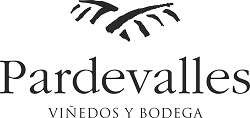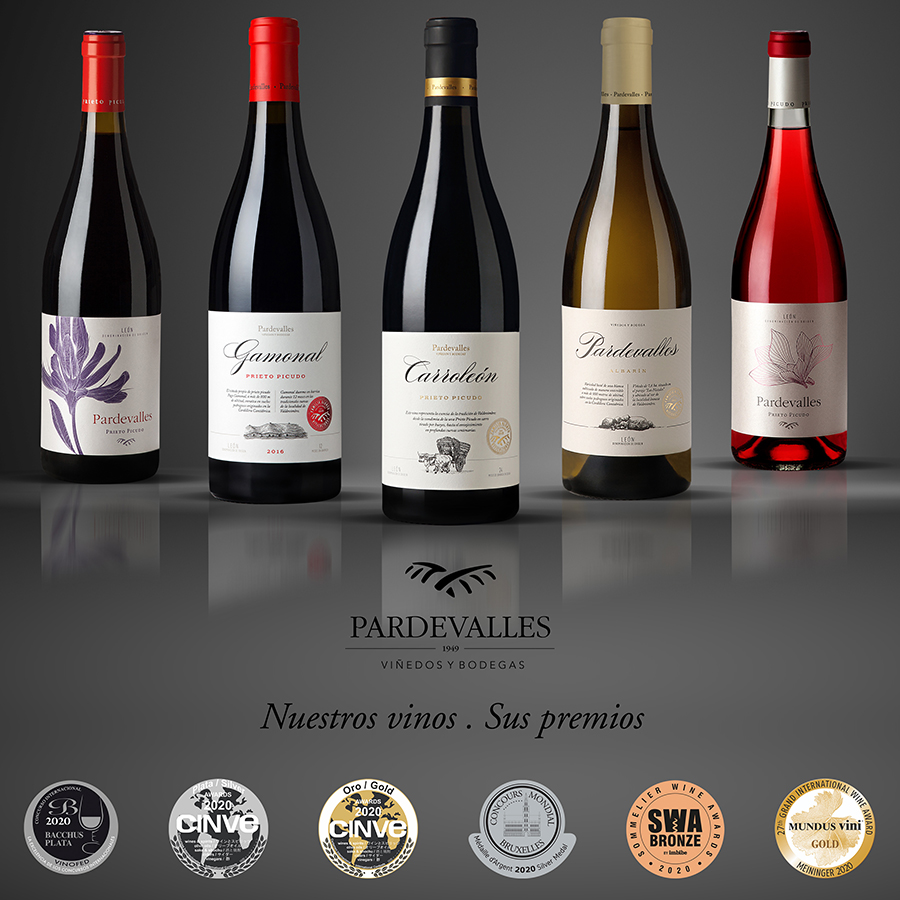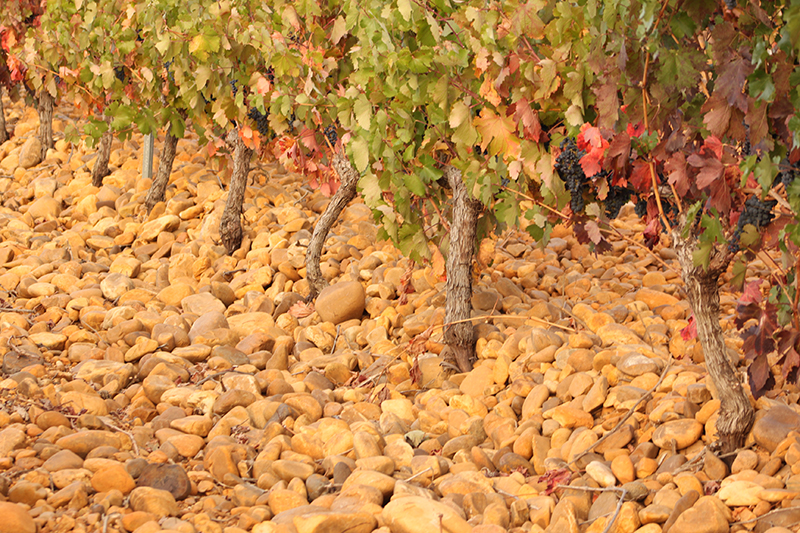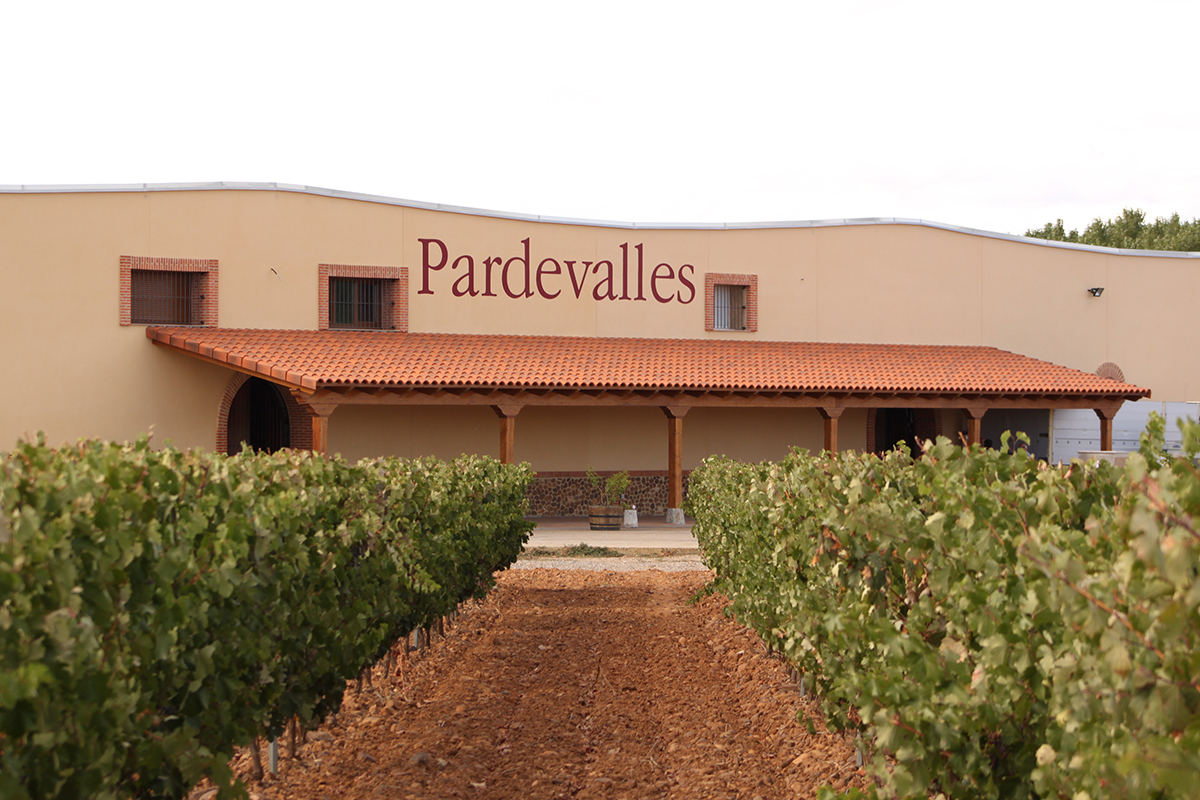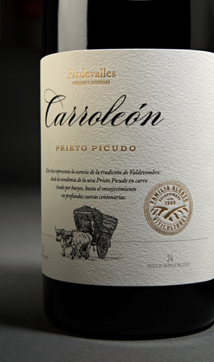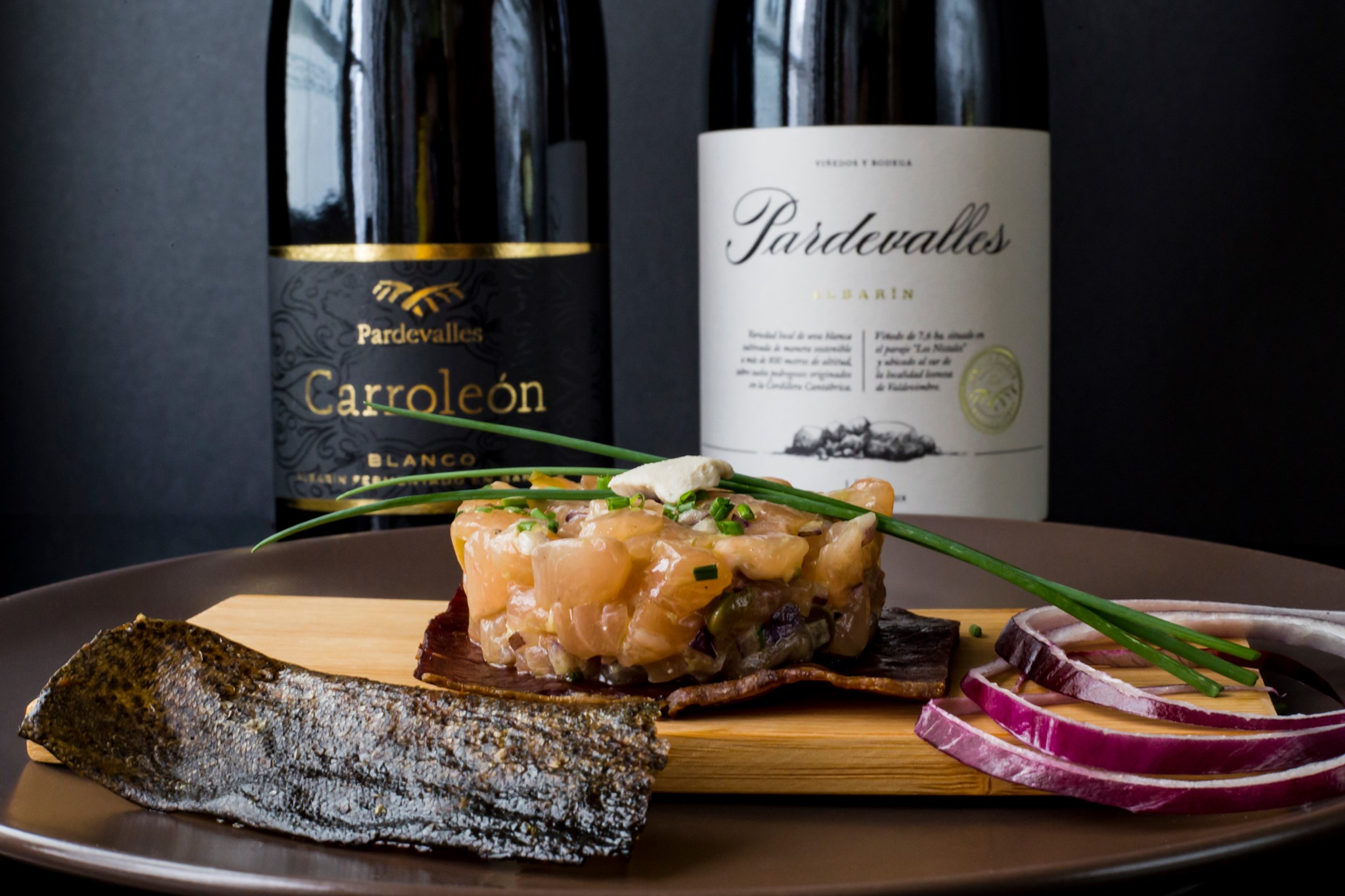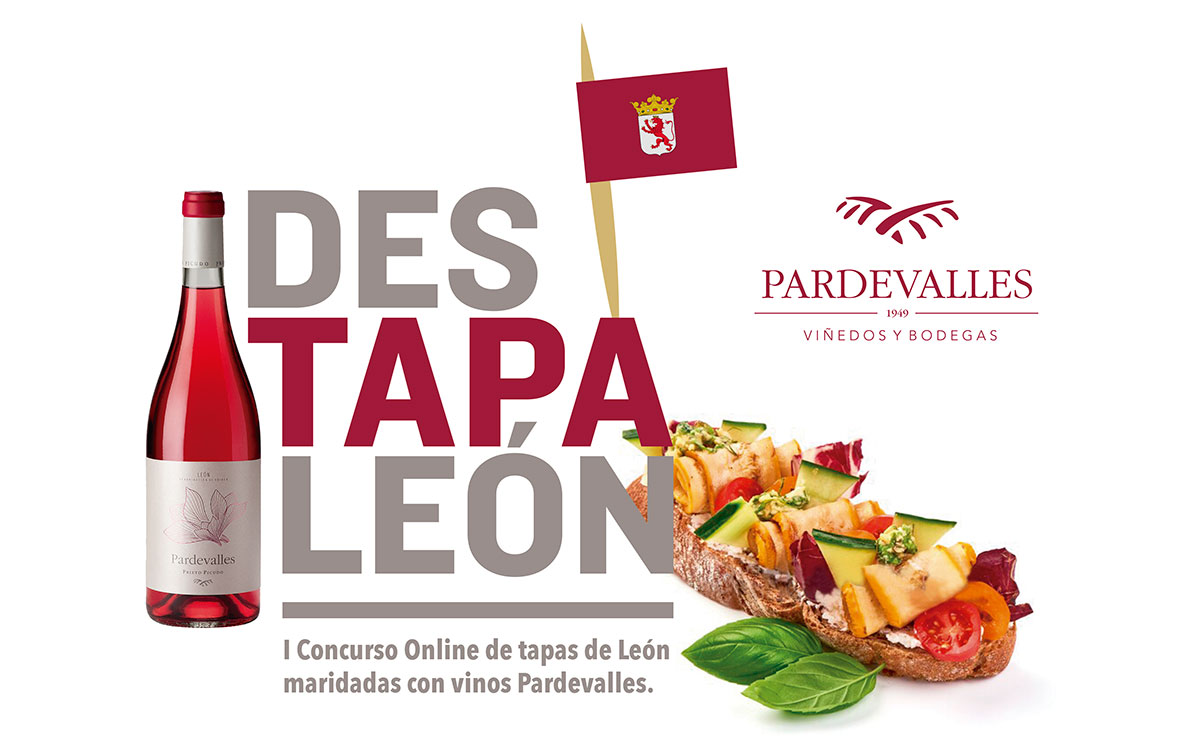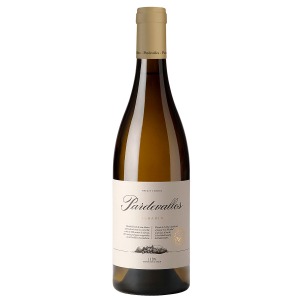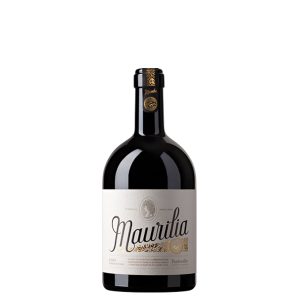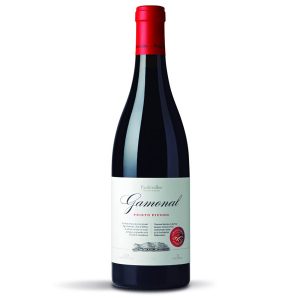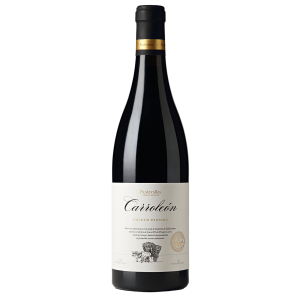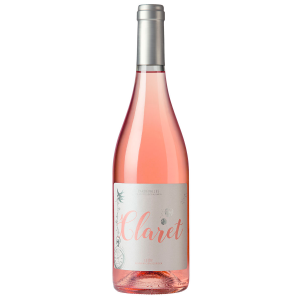2 December, 2021
The flagship winery located in Valdevimbre puts the finishing touch to a year full of success and recognition. A notoriety whose effects transcend beyond the winery and serve to elevate and make known one of the D.O. with more projection and future of our country, the D.O. Lion.
2021 has served to consolidate the wines belonging to this region in the south of León. And, if there is a winery that represents the values of the wine culture of this area, it is Pardevalles. A winery with a family tradition that, to this day, has managed to travel beyond the borders of this province and make itself known both nationally and abroad.
This year has been a year of recognition for the work, effort and tenacity with which the Alonso family of winegrowers are making their winery grow and, by extension, publicizing the magnificent wines that are made in our land, under the Prieto varieties. Picudo and Albarin. Thus, Pardevalles adds 8 new awards to its list of winners obtained during this 2021:
New strengths for quality wines
You have already seen that Pardevalles does not cease in its efforts to continue producing wines of the highest quality, something that is reflected in the 8 new awards it has received. But, which wines have stood out the most? Next, we break down the awards that each wine belonging to this winery has won:
Pink pardevalles, the winning horse
Rosé wine is perhaps the one with the most deeply rooted tradition in this area of León. Who hasn't come out of short films accompanying tapas with a claret? In fact, together with the D.O Navarra and the D.O. Penedés, the D.O. León is the one that produces and markets the most variety of rosé wines. Specifically, the Pardevalles rosé, which is made entirely from the Prieto Picudo grape, has an intense, very bright pink color, perfect for combining with almost any dish, since it combines the intensity required by more forceful dishes with the fineness and delicate balance perfect for softer recipes. Thus, the pink Pardevalles has obtained the following awards in 2021, in addition to those it already had:
VinDuero Awards – VinDouro: this is the most prestigious contest that recognizes the best wines from Spain and Portugal. This year it has celebrated its 17th edition, and in it it has awarded Pardevalles rosé as the best rosé wine of 2021 in the Iberian Peninsula.
Zarcillo de Oro: the Zarcillo awards symbolize the excellence that the international wine competition that, since 1991, has been held by the Junta de Castilla y León wants to represent. Thus, the Pardevalles rosé of the 2020 vintage has obtained the Golden Zarcillo, as one of the three representatives of the D.O. Leon to do it.
Brussels International Contest Rosé Edition: the prestigious contest organized rewards the best wines from around the world in different categories. The Pardevalles Rosado 2020 was awarded the silver medal in the rosé category.
Atlantic: the Atlantic-influenced wine contest has held its second edition in tin, and in it has awarded Klaret, the organic rosé wine from Pardevalles, the award for best rosé.
White albarín, a great unknown
Another of the wines that has obtained the most recognition throughout this year is the white Albarín, made from the homonymous grape grown in this region of Leon. And, without a doubt, we could qualify these wines as the most surprising of the D.O. Lion; and it is that, far from resembling other whites that are softer and where the grape is less noticeable, in this case the Albarín is characterized by being a more complex white wine, where the fruity notes more typical of this wine are intermingled with other herbaceous in nature. The result is a white wine with more body and consistency, which has also been recognized in 2021 outside our country:
Cathay Pacific Competition (Hong Kong): this international competition that takes place in Hong Kong has awarded the white Albarin with the bronze medal in this competition.
National Small D.O. Contest: this contest, which has celebrated its fifth edition this year, has awarded Pardevalles with the gold medal for the white Albarín.
Sommelier Wine Awards 2020: the pandemic made it impossible to hold this British event last year. For this reason, the prizes have been awarded recently, and Pardevalles won the bronze medal for the 2019 vintage white Albarín.
Peñín Guide, the great indicator at the national level
In addition to the recognitions and prizes obtained internationally, in Spain we have a very important reference in the wine sector: the Peñín Guide. It is the most important to measure the level of excellence and quality of Spanish wines, which makes it more difficult to achieve a good score. Despite this, Pardevalles is the only winery in the D.O. León, in which almost all its wines have achieved more than 90 points in the Peñín Guide. Pink Pardevalles.
Achieving a score of over 90 is essential to participate in the Salón de los Mejores Vinos de España, which took place at the end of November in Madrid. Thus, Pardevalles participated as the main representation of León wines in a renowned fair with a marked international character.
The beginning of a long way to go
In short, 2021 ends as a year of recognition and projection for the wines of the D.O. León, both for the quality of its autochthonous grapes and for the marked winemaking tradition of this region. A projection that, far from fading away, has only just begun to take off. Proof of this is the set of awards received by the wineries that belong to the D.O. León, with Pardevalles as one of its top representatives. In fact, these 8 awards that he has obtained this year complete a list of awards that is already around 100 awards obtained in the last 25 years.
At Pardevalles we feel very fortunate, as well as proud, to help make León wines increasingly known and admired, both in the rest of Spain and throughout the world. Our work has only just begun. [...]
17 November, 2021
November arrives, and with it, the cold in León. Gone are the days of heat in which you had to shelter from the sun, to give way to frigid temperatures that invite you to look for any minimum ray that can warm you. Once the harvest season is over, it is time to start thinking about the next natural step in the vineyard: pruning. However, there are many doubts about when it should be done, what types are there and how it should be done. In this post we will try to solve them all.
Pruning is one of the most important processes in viticulture, since it contributes to the regulation and balance of the plant. It facilitates the circulation of the sap by eliminating dry buds, prevents the spread of diseases and reduces the aging of the vine.
Viticulture is by no means an exact science. It depends on external factors that can alter the usual course of the actions that are carried out. The weather is mainly responsible for the harvest starting at one time or another of the year, and it also has a great influence on subsequent pruning. The conditions of each wine region are different, and also have a direct impact on all these actions.
The vegetative cycle of the vine is marked by certain moments that can condition, positively or negatively, the result of the harvest. One of those moments is pruning, which is more important than you might think a priori. In addition, it is not done the same in all vineyards, but rather depends on the planting method, the amount of water in the land and the age of the plant, among other factors.
When should pruning be done?
This is the first question where there is no single answer. What is certain is that it must be done when the plant has already completed its productive cycle and has lost all its leaves. At that moment, the vine enters a lethargic process, in which the buds are “asleep” after having paid off. Winter pruning is usually done on dry, cold days, since low temperatures prevent the plant from developing infections.
Even so, the vine's vegetative rest process usually lasts several months, beginning approximately in November and until the arrival of spring. If the pruning is carried out between the months of November and January, we will talk about early pruning. If it takes place in February and March, it will be late pruning. In either case, pruning is done dry. However, there are viticulturists and areas in which the so-called green pruning is also carried out.
Green pruning is complementary to winter pruning, and it is not always carried out, only in highly productive vineyards or when low productions are sought to increase the quality of the grapes when it is going to be used for the production of more special wines. The time to do this pruning is spring, when sprouting has already begun.
How do I know when it is best to start pruning?
It depends on several factors. If, for example, you are going to perform manual pruning or you do not have large resources, it is recommended that you start soon. In this way, you make sure that the plant reaches the spring fully pruned. The age of the plant also affects: if it is a young vine it is preferable to wait for late pruning, while plants over 3 years old are more resistant to temperature differences and can be pruned earlier.
Another factor that can condition this moment is the orientation of the vineyards. If they do not receive excessive sun, it is more convenient to wait to prune, thus preventing moisture from spreading through the plant and causing infections.
What types of pruning are there?
There is no single classification of the types that can be carried out, but it depends on what criteria you base yourself on:
If we take into account the life cycle of the plant, we distinguish between the following typologies:
Formation pruning: it is the one that is carried out during the first years of the vine. This is when it is convenient to adapt the plant to the cultivation method that we want.
Maintenance pruning: when the first years of adaptation have passed, maintenance pruning is carried out. It is intended to maintain the balance of the plant.
Rejuvenation pruning: in this case, the objective is to eliminate the parts that have become older to increase the life of the plant and optimize its development in the next harvest.
Transformation pruning: this pruning is carried out in cases where the productivity of the vine is very low, or when what is sought is to modify its management system.
If we look at the driving system; that is, the cultivation method that we have chosen, we distinguish between:
Guyot system: we are talking about a mixed method in the head where there are short (thumbs) and long (rods) elements.
Goblet: if the plant is in the so-called goblet formation, pruning will be done in thumbs or forks.
On a trellis: a cord is formed in which there may be one or two arms, in which case it would be called Royat. This type of pruning is usually done on thumbs, leaving about 5 for each arm.
Depending on the type of intervention that is carried out, we also distinguish between three types of pruning:
Manual: it should be borne in mind that, if the formation of the vine is in a glass, pruning must always be done manually, which means that it takes more time to complete.
Mechanics: it is possible when the plant is developed on a trellis. Mechanical pruning usually leads to a larger production, but it also requires more water and can age the vineyard earlier, as it is not a natural process.
Mixed: there are some vineyards that choose to perform winter pruning manually and spring pruning mechanized, or vice versa. In this case, we are talking about mixed pruning.
Vine pruning is a process that requires technique, knowledge of the soil and the plant, and perseverance. Good viticulturists combine these three qualities, which will result in a much more optimal vine sanitation and, consequently, a better harvest. Even within the same geographical area or designation of origin, not all vineyards have the same characteristics to make it. The key lies in knowing in depth what your vineyard is like, taking into account the weather, humidity and soil conditions, and treating the plant with delicacy and great care. [...]
21 October, 2021Ha llegado octubre y, con él, la tan esperada vendimia anual en León. Y es que la vendimia es el momento clave para cualquier bodeguero, es la época del año en la que se ve si la cosecha será buena o no. Este proceso es mucho más complejo de lo que, a priori, pueda parecer. No solo por la propia recolección de la uva, que debe hacerse con sumo cuidado. También porque entran en juego una serie de factores externos que pueden influir, y mucho, en el estado de la uva. En este artículo te contamos cómo se realiza la vendimia, las claves que debemos tener en cuenta y cómo se logra encontrar el equilibrio perfecto entre acidez y madurez de la uva para saber que está en su punto ideal.
Lo primero que conviene saber es que no hay una fecha exacta para vendimiar, sino que esta dependerá del tipo de uva y las condiciones climatológicas, principalmente. Dentro de las uvas autóctonas de León encontramos diferencias sustanciales que hacen que las épocas de vendimia varíen, pese a tratarse de la misma provincia. Así, la D.O. Bierzo suele vendimiar unas semanas antes que la D.O. León, debido a que esta zona cuenta con temperaturas más altas que favorecen la maduración de la uva. En cambio, la zona de viñedos situada en la comarca de Valdevimbre y alrededores necesita algunas semanas más para vendimiar, ya que la temperatura es más baja.
Cada vendimia es un mundo, de eso no cabe duda. El éxito de la misma radica en un trabajo perfectamente coordinado entre el bodeguero, el viticultor y el enólogo. Entre los tres deben analizar y observar el estado de la uva prácticamente a diario, para determinar cuándo es el momento exacto para vendimiar. Todo ello, teniendo siempre en cuenta la previsión meteorológica. De esta forma se evitan las posibles y habituales lluvias que por estas fechas pueden complicar la vendimia.
¿Cómo se sabe cuándo es el momento de vendimiar?
Cada tipo de vino requiere una maduración diferente de la uva, y cada tipo de uva madura a un ritmo distinto. La clave está en determinar cuándo se produce el mayor equilibrio posible entre todos estos componentes para dar con el vino perfecto. Es aquí donde entra en juego la sabiduría conjunta del bodeguero, el enólogo y el viticultor. Cada uno de estos actores ofrece su conocimiento y experiencia para alcanzar el consenso sobre cuándo es el mejor momento para recoger la uva. La maduración de la uva está relacionada con el nivel de azúcar, la madurez de la piel e incluso de la semilla:
Maduración fisiológica: el nivel de azúcar que adquiera cada uva repercutirá en el grado de alcohol, puesto que en el proceso de fermentación, una mayor cantidad de azúcar se traducirá en más graduación alcohólica. Es importante encontrar un tándem entre el azúcar y la acidez.
Maduración fenólica: la uva está formada por fenoles, los compuestos orgánicos que le proporcionan la textura, el color y sabor. Si hablamos de fenoles, debemos hablar de flavonoles, taninos y antocianos. Estos compuestos están presentes tanto en el hollejo de la uva como en las semillas, por lo que es importante también atender a la maduración de ambos aspectos para lograr un buen resultado.
Condiciones climatológicas y del suelo: ¿Cómo influyen en la vendimia?
Decíamos antes que cada vendimia es un mundo, y en el desarrollo de la misma, así como en el resultado de la uva, dependen varios factores. Pero, fundamentalmente, dos: el clima y el tipo de suelo. En lo que se refiere a las características de la tierra, cabe destacar que la maduración de la uva no es igual si la viña está en un suelo pedregoso que si se ubica en uno arcilloso o calizo.
Generalmente se suele decir que la planta de la vid se desarrolla mejor en suelos pobres. No obstante, también se consiguen vinos extraordinarios en suelos más fértiles. El papel del viticultor es fundamental, pues es la persona que mejor conoce el suelo y sabe cómo tratarlo para que la cosecha crezca de la mejor forma posible.
Si hablamos del clima, hay varios elementos que debemos tener en cuenta: la temperatura, la diferencia térmica entre el día y la noche, la humedad, la orientación del viñedo, la agresividad del viento, etc. El cambio climático, que ha provocado que este año la temperatura del mes de octubre sea 10 grados superior a la de años anteriores, tiene un efecto directo en la maduración de la uva. Cuanto más calor hace, antes madura la uva y, por tanto, más puede aumentar su graduación alcohólica.
Asimismo, un período de lluvia excesiva justo antes de la vendimia puede no ser lo más adecuado para la misma. Si la uva tiene exceso de agua, se diluirán más sus aromas, porque estará menos concentrado. Este es el principal motivo por el cual no es conveniente vendimiar cuando la uva está todavía mojada. Además, un exceso de humedad en la planta puede provocar la aparición de hongos que la dañen.
La vendimia, paso a paso
El proceso de vendimia requiere unos pasos muy bien estructurados y un orden lógico que no se puede alterar:
1. Controles continuos previos a la vendimia: el enólogo, el bodeguero y el viticultor deben examinar la uva prácticamente a diario. De esta forma pueden ver su evolución y controlar, de manera más efectiva, el proceso de maduración de la misma.
Recolección: la recogida de la uva se puede llevar a cabo de forma manual o mecánica. También existen otros tipos de recogida, como la vendimia nocturna o la tardía.
Control posterior: cuando la uva recogida llega a la bodega, se realizan una serie de controles para determinar la validez de la misma. Así, se pesa, se mide su grado de alcohol y se eliminan aquellas que no superen los controles de calidad.
Despalillado: este proceso se realiza solo con las uvas que han pasado el control de calidad, y consiste en separarlas del raspón y de otras partículas vegetales que pueden acompañar al racimo.
Estrujado: Consiste en romper las uvas para conseguir una pasta homogénea formada por mosto, pieles y pepitas.
Maceración y fermentaciones: una vez se ha estrujado la uva, se realiza la maceración para conseguir que el mosto extraiga todos los componentes aromáticos y polifenoles que se encuentran principalmente en las pieles y pepitas. En la elaboración de vinos blancos y rosados la maceración es únicamente prefermentativa, con una duración de uno o dos días, momento en el cual se realiza el sangrado para separar el mosto de las pieles y pepitas. Los mostos fermentarán por si solos con la actuación de las levaduras que transformarán el azúcar en alcohol, convirtiendo el mosto en vino. En el caso de los vinos tintos la maceración re realiza durante toda la fermentación, de ahí que los vinos tintos extraigan todo el color de las pieles y lo más importante, los taninos de las pepitas. Una vez finalizada la fermentación se realiza el descube para separar, en este caso el vino tinto de las pieles y pepitas. En ambos casos, estos últimos, comúnmente llamados orujos se van a destinar a la elaboración de aguardientes por destilación.
Crianza: Algunos vinos, tras la fermentación, se llevan a reposar a barricas de roble, generalmente de 225 litros. El objetivo es conseguir una crianza que aportará a los vinos aromas a los tostados de la barrica y la propia madera. Además de redondear los taninos y oxigenar los vinos, entre otras cosas.
La vendimia es el momento clave del año para las bodegas. Saber exactamente cuándo es más idóneo recoger la uva es fundamental para aprovechar todo el potencial de la misma para la elaboración de unos vinos u otros. En esta decisión influyen factores externos que deben analizarse con precisión, como la climatología o el grado de maduración de la uva. Cada vendimia es diferente porque cada viñedo es único. Lo importante es conocer la tierra, saber detectar el equilibrio perfecto entre los distintos componentes de la uva y elegir el momento exacto para cosecharla. [...]
3 October, 2021León celebrates this week its big festivity, San Froilán. A day in which families get together to enjoy a parade that, for many Leonese, is the most anticipated moment of the year. We talked, of course, about the parade of banners and decorated cars. An exhibition of strength, family roots, tradition and native customs that reminds us what it means to be Leonese.
Contrary to what you might think a priori, it is not a tribute to the patron saint of the city, since that is not San Froilán but San Marcelo. So, you will ask yourself, why is the festival of San Froilán so important? The origin dates back to a popularity that grew until it became history and tradition.
León and San Froilán: a relationship of more than ten centuries old
We go back more than ten centuries and move to the end of the 9th century and the beginning of the 10th century. The then monarch Alfonso III entrusted the young Froilán with an important mission: to spread the word of God and evangelize the entire southern region of the Astur-Leonese kingdom. Over the years, Froilán's fame grew along with the population, to the point that the town itself proposed him as the new Bishop of León. Thus, in the year 900, the Leonese attended the appointment of Froilán as leader of the church of León.
Five years later, the moment that no one thought would come occurs: the death of Froilán. It would not be until the 12th century when Pope Urban II decided to canonize him, thus giving rise to the homage that the people of León pay every year to their beloved Saint Froilán.
The adorned cars, the best tribute to the rural world of Leon
The week of San Froilán is full of activities and events that are repeated year after year with the same enthusiasm. One of the most important is the parade of decorated cars, in which the people of León throw the house out the window and bring out their best weapons, usually with agricultural and livestock motifs. The reason? Win the contest that is held every year and be crowned the best decorated car in the region.
Countrymen from different areas of the province of León meet in the capital, where they come with their old cars adorned with their best clothes. The carts, in turn, are pulled by pairs of donkeys, horses, oxen and cows, in the same way as was done in the past when the cart was the only means of transport available. The objective of the parade is none other than to honor the way to the sanctuary of the Virgen del Camino in the traditional pilgrimage.
A pride that goes beyond San Froilán
The adorned cars are, without a doubt, one of the greatest emblems of the province of León. An icon that, far from remaining a mere celebration, has become a symbol with its own identity. It should be remembered that the celebration of decorated cars coincides with the harvest season. Viticulture is one of the sectors with the most economic weight in the region, and thanks to the quality of the wines from the D.O. León, has also become a symbol outside our borders.
The feeling of pride aroused by decorated cars is transferred to the world of wine by the hand of Pardevalles. The winery pays its own tribute to this tradition through Carroleón, its most select wine.
Carroleón represents the essence of the Valdevimbre tradition, from the harvest of the native Prieto Picudo grape in a cart pulled by oxen, to its aging in centuries-old caves.
This is the legend that reads the new label that “decks” the Carroleón bottle, thus uniting two of the most characteristic emblems of our province.
Carroleón: excellence and power of the autochthonous grape from León
In its red version, Carroleón waits between 20 and 24 months in French oak barrels, which gives it that cherry-garnet color with unmistakable purple tones. With a total of 92 points in the Peñín Guide and countless awards to its credit, the most recent being Gold in Vinduero, Carroleón Reserva is a clear example of how it is possible to squeeze the most out of a grape's properties as characteristic as the Prieto Picudo.
In addition to the red wine, Carroleón also has a white wine version. In this case, from the Albarín Blanco grape, 100% native to this region. The maceration of the broth occurs in French oak barrels and subsequent aging in barrels on its own lees for five months.
Pardevalles' commitment to spreading Leonese culture beyond our borders is stronger than ever, and this is demonstrated by Carroleón, the “decked out wine” In addition to the red wine, Carroleón also has a white wine version. In this case, from the Albarín Blanco grape, 100% native to this region. The maceration of the broth occurs in French oak barrels and subsequent aging in barrels on its own lees for five months. [...]
19 May, 2020I online tapas contest in León.
PRIZE
Varied lot of León products, and Pardevalles wines + Donation of a check for € 1000 in Pardevalles products to the Bar or Restaurant that the winner chooses.
LID NAME
“ESLA NYMPH IN ROYAL BED” paired with Pardevalles Albarín and Carroleón Blanco. Picos de Europa dairies, Entrepeñas Sausages, Ezequiel Sausages, el Pinar Sausages, CECINAS NIETO
CONTESTANT
MIGUEL ANGEL BORRAZ GUTIÉRREZ
1st Leon Tapas Online Contest.
PRIZE
Varied lot of products from León, and Pardevalles wines + Donation of a €500 check in Pardevalles products to the Bar or Restaurant that the winner chooses.
CAP NAME
“ALCAFÉ CAZURRO” paired with Pardevalles Albarín. Picos de Europa Dairy Products, Entrepeñas Sausages, Ezequiel Sausages, El Pinar Sausages CECINAS NIETO
CONTESTANT
SORAYA ALVAREZ MARTINEZ.
1st Leon Tapas Online Contest.
PRIZE
Varied lot of products from León, and Pardevalles wines + Donation of a €250 check in Pardevalles products to the Bar or Restaurant that the winner chooses.
CAP NAME
“SABORES DE LEÓN” paired with Pardevalles Albarín. Conservas vega esla, La Huerta de Fresno, Praizal Cheese Factory, El Palacio Cheese Factory, Grandfather Aitalas, Los Payuelos Cheese Factory
CONTESTANT
NURIA FERNANDEZ CASTANO
1st Leon Tapas Online Contest.
PRIZE
Lot of Pardevalles wines, visit to the winery for two people plus free registration to Focus León Photography for one year.
CAP NAME
“LION IN THE HAND” paired with Pardevalles Albarin. Entrepeñas Sausages, Pinar Sausages, Ezequiel Sausages, Morcillas Morvega. Suárez Meat Crafts. CECINAS GRANDSON
CONTESTANT
AMPARO RODRIGUEZ GARCIA
I León online tapas contest.
PRIZE
Lot of Pardevalles wines plus a visit to the winery for two people.
NAME
"GYOSA BOLEONESA" paired with Pardevalles Gamonal 2016. Entrepeñas Sausages, Ezequiel Sausages, El Pinar Sausages, CECINAS NIETO
CONTESTANT
ANTONIO GARCIA RIOL. [...]
1 May, 2020Competition rules
Recipients: Professionals and non-professionals. Participation: Free.
Development and Evaluations: Elaboration of a skewer or tapa with products from León paired with any of the wines from
Pardevalles, vineyards and winery. Contestants must send a photo of the skewer or tapa accompanied by a drink or
bottle of any of the wines from the winery.
The presence of the elaboration, the photographic composition, the use of products of
Leon and the originality of the name.
Jury: Made up of professionals from the Sector: Juanjo Losada from Pablos Restaurant, Javier Rodriguez from Delirios Restaurant,
Rafael Blanco as president of the DO León, Ramón Villa as president of the Leonese Academy of Gastronomy, Martín
Méndez as president of the León Hoteliers Association, Cori Fenandez as president of Focus León, Javier Carlón de
Carlón sabores, Juan Flecha from the Gastronomic Guide of León, among others.
Dates of reception of the photographs: from May 3 to 10 included.
Method of sending the photographs and guidelines: Sending them by mail to Info@pardevalles.es adding the name of the cover
and a brief description of the preparation and products used, providing a name and contact telephone number of the participant.
Awards:
1st Prize: Assorted lot of products from León and Pardevalles wines plus a check for 1000 euros in Pardevalles products that
they will be donated to the Bar or restaurant that the winner chooses.
2nd Prize: Assorted lot of products from León and Pardevalles wines plus a check for 500 euros in Pardevalles products that will be
donated to the Bar or restaurant of the winner's choice.
3rd Prize: Assorted batch of products from León and Pardevalles wines plus a check for 250 euros in Pardevalles products that will be
donated to the Bar or restaurant of the winner's choice.
4th Prize: Lot of Pardevalles wines plus tasting visit to the winery for 2 people plus free registration to Focus León during
one year.
5th Prize: Lot of Pardevalles wines plus a tasting visit to the winery for 2 people.
Collaborators [...]


